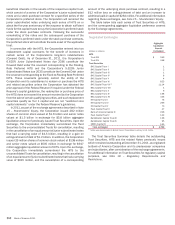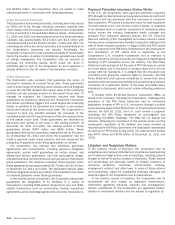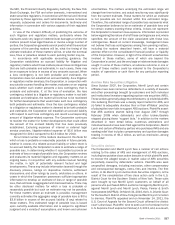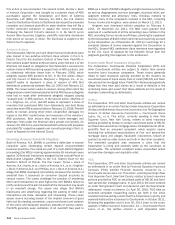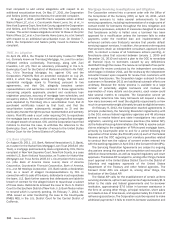Bank of America 2011 Annual Report Download - page 218
Download and view the complete annual report
Please find page 218 of the 2011 Bank of America annual report below. You can navigate through the pages in the report by either clicking on the pages listed below, or by using the keyword search tool below to find specific information within the annual report.216 Bank of America 2011
and $139.5 billion. The Corporation does not expect to make
material payments in connection with these guarantees.
Other Derivative Contracts
The Corporation funds selected assets, including securities issued
by CDOs and CLOs, through derivative contracts, typically total
return swaps, with third parties and VIEs that are not consolidated
on the Corporation’s Consolidated Balance Sheet. At December
31, 2011 and 2010, the total notional amount of these derivative
contracts was approximately $3.2 billion and $4.3 billion with
commercial banks and $1.8 billion and $1.7 billion with VIEs. The
underlying securities are senior securities and substantially all of
the Corporation’s exposures are insured. Accordingly, the
Corporation’s exposure to loss consists principally of counterparty
risk to the insurers. In certain circumstances, generally as a result
of ratings downgrades, the Corporation may be required to
purchase the underlying assets, which would not result in
additional gain or loss to the Corporation as such exposure is
already reflected in the fair value of the derivative contracts.
Other Guarantees
The Corporation sells products that guarantee the return of
principal to investors at a preset future date. These guarantees
cover a broad range of underlying asset classes and are designed
to cover the shortfall between the market value of the underlying
portfolio and the principal amount on the preset future date. To
manage its exposure, the Corporation requires that these
guarantees be backed by structural and investment constraints
and certain pre-defined triggers that would require the underlying
assets or portfolio to be liquidated and invested in zero-coupon
bonds that mature at the preset future date. The Corporation is
required to fund any shortfall between the proceeds of the
liquidated assets and the purchase price of the zero-coupon bonds
at the preset future date. These guarantees are recorded as
derivatives and carried at fair value in the trading portfolio. At
December 31, 2011 and 2010, the notional amount of these
guarantees totaled $300 million and $666 million. These
guarantees have various maturities ranging from two to five years.
As of December 31, 2011 and 2010, the Corporation had not
made a payment under these products and has assessed the
probability of payments under these guarantees as remote.
The Corporation has entered into additional guarantee
agreements and commitments, including lease-end obligation
agreements, partial credit guarantees on certain leases, real
estate joint venture guarantees, sold risk participation swaps,
divested business commitments and sold put options that require
gross settlement. The maximum potential future payment under
these agreements was approximately $3.7 billion and $3.4 billion
at December 31, 2011 and 2010. The estimated maturity dates
of these obligations extend up to 2033. The Corporation has made
no material payments under these guarantees.
In the normal course of business, the Corporation periodically
guarantees the obligations of its affiliates in a variety of
transactions including ISDA-related transactions and non ISDA-
related transactions such as commodities trading, repurchase
agreements, prime brokerage agreements and other transactions.
Payment Protection Insurance Claims Matter
In the U.K., the Corporation sells payment protection insurance
(PPI) through its international card services business to credit card
customers and has previously sold this insurance to consumer
loan customers. PPI covers a consumer’s loan for debt repayment
if certain events occur such as loss of job or illness. In response
to an elevated level of customer complaints of misleading sales
tactics across the industry, heightened media coverage and
pressure from consumer advocacy groups, the U.K. Financial
Services Authority (FSA) investigated and raised concerns about
the way some companies have handled complaints relating to the
sale of these insurance policies. In August 2010, the FSA issued
a policy statement (the FSA Policy Statement) on the assessment
and remediation of PPI claims that is applicable to the
Corporation’s U.K. consumer businesses and is intended to
address concerns among consumers and regulators regarding the
handling of PPI complaints across the industry. The FSA Policy
Statement sets standards for the sale of PPI that apply to current
and prior sales, and in the event a company does not or did not
comply with the standards, it is alleged that the insurance was
incorrectly sold, giving the customer rights to remedies. The FSA
Policy Statement also requires companies to review their sales
practices and to proactively remediate non-complaining customers
if evidence of a systematic breach of the newly articulated sales
standards is discovered, which could include refunding premiums
paid.
In October 2010, the British Bankers’ Association (BBA), on
behalf of its members, including the Corporation, challenged the
provisions of the FSA Policy Statement and its retroactive
application to sales of PPI to U.K. consumers through a judicial
review process against the FSA and the U.K. Financial Ombudsman
Service. On April 20, 2011, the U.K. court issued a judgment
upholding the FSA Policy Statement as promulgated and
dismissing the BBA’s challenge. The BBA did not appeal the
decision. Following the conclusion of the judicial review and the
subsequent completion of the detailed root cause analysis as
required by the FSA Policy Statement, the Corporation reassessed
its reserve for PPI claims during 2010. The total accrued liability
was $476 million and $700 million at December 31, 2011 and
2010.
Litigation and Regulatory Matters
In the ordinary course of business, the Corporation and its
subsidiaries are routinely defendants in or parties to many pending
and threatened legal actions and proceedings, including actions
brought on behalf of various classes of claimants. These actions
and proceedings are generally based on alleged violations of
consumer protection, securities, environmental, banking,
employment, contract and other laws. In some of these actions
and proceedings, claims for substantial monetary damages are
asserted against the Corporation and its subsidiaries.
In the ordinary course of business, the Corporation and its
subsidiaries are also subject to regulatory examinations,
information gathering requests, inquiries and investigations.
Certain subsidiaries of the Corporation are registered broker/
dealers or investment advisors and are subject to regulation by








